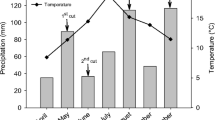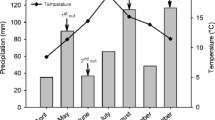Abstract
It was the aim of this study to determine the way in which low temperature modifies the effect of a competing grass on nitrogen fixation of a forage legume. White clover (Trifolium repens L.) was grown in monoculture or in different planting ratios with timothy (Phleum pratense L.) or perennial ryegress (Lolium perenne L.) in growth chambers at either 7.5/5°C (LoT) or 15/10°C (HiT) average day/night temperatures, and with 2.5 or 7.5 mM 15N-labelled nitrate in the nutrient solution.
Competition with grass led to a marked increase in the proportion of clover nitrogen derived from symbiosis (% Nsym). This increase was slower at LoT where % Nsym was reduced considerably; it was closely related to the reduction in the amount of available nitrate as a result of its being utilized by the grass.
Nitrogen concentration in white clover herbage and dry matter yield per clover plant were reduced, for the most part, when a competing grass was present. The amount of nitrogen fixed per plant of white clover decreased markedly with temperature. Low temperature consequently accentuated competition for nitrate. The capacity of white clover to compete successfully was limited by its slower growth and nitrogen accumulation.
Similar content being viewed by others
References
BollerB C and NösbergerJ 1987 Symbiotically fixed nitrogen from field-grown white and red clover mixed with rye-grasses at low levels of 15N-fertilization. Plant and Soil 104, 219–226.
ChalametA, AudergonJ M and MaitreJ P 1984 Concurrence entre une graminée (Lolium multiflorum Lamk.) et une légumineuse (Trifolium pratense L.): Utilisation du 15N pour l'étude de la nutrition azotée. Acta Oecologica/ Oecol. Plant. 4, 125–133.
CralleH T and HeichelG H 1982 Temperature and chilling sensitivity of nodule nitrogenase activity in unhardened alfalfa. Crop. Sci. 22, 300–304.
EdmeadesD C and GohK M 1978 Symbiotic nitrogen fixation in a sequence of pastures of inceasing age measured by a 15N dilution technique. N.Z. J. Agric. Res. 21, 623–628.
HammerP A, TibbittsT W, LanghansR W and McFarlaneJ C 1978 Base-line growth studies of ‘Grand Rapids’ lettuce in controlled environment. J. Am. Soc. Hortic. Sci. 103, 649–655.
Kessler W 1987 Einfluss des Lichtangebotes und der Temperatur auf die Ertragsbildung und die biologische Stickstoff-Fixierung von Weissklee. ETH Zürich, Dissertation no. 8375, 70 p.
MitchellK J 1956 Growth of pasture species under controlled environment. I. Growth at various levels of constant temperature. N.Z. J. Sci. Techn. 38A, 203–216.
RoughleyR J and DartP J 1970 Growth of rTrifolium subterraneum L. selected for sparse and abundant nodulation as affected by root temperature and Rhizobium strain. J. Exp. Bot. 21, 776–786.
SprinsonD B and RittenbergD 1949 The rate of utilization of ammonia for protein synthesis. J. Biol. Chem. 180, 707–714.
TaT C and FarisM A 1987 Effects of alfalfa proportions and clipping frequencies on timothy-alfalfa mixtures. II. Nitrogen fixation and transfer. Agron. J. 79, 820–824.
WestC P and WedinW F 1985 Dinitrogen fixation in alfalfa-orchardgrass pastures. Agron. J. 77, 89–94.
Author information
Authors and Affiliations
Rights and permissions
About this article
Cite this article
Nesheim, L., Boller, B.C. Nitrogen fixation by white clover when competing with grasses at moderately low temperatures. Plant Soil 133, 47–56 (1991). https://doi.org/10.1007/BF00011898
Received:
Issue Date:
DOI: https://doi.org/10.1007/BF00011898




